
Feature Transformations#
Michael J. Pyrcz, Professor, The University of Texas at Austin
Twitter | GitHub | Website | GoogleScholar | Geostatistics Book | YouTube | Applied Geostats in Python e-book | Applied Machine Learning in Python e-book | LinkedIn
Chapter of e-book “Applied Machine Learning in Python: a Hands-on Guide with Code”.
Cite this e-Book as:
Pyrcz, M.J., 2024, Applied Machine Learning in Python: A Hands-on Guide with Code [e-book]. Zenodo. doi:10.5281/zenodo.15169138
The workflows in this book and more are available here:
Cite the MachineLearningDemos GitHub Repository as:
Pyrcz, M.J., 2024, MachineLearningDemos: Python Machine Learning Demonstration Workflows Repository (0.0.3) [Software]. Zenodo. DOI: 10.5281/zenodo.13835312. GitHub repository: GeostatsGuy/MachineLearningDemos
By Michael J. Pyrcz
© Copyright 2024.
This chapter is a tutorial for / demonstration of Feature Transformations.
YouTube Lecture: check out my lectures on:
These lectures are all part of my Machine Learning Course on YouTube with linked well-documented Python workflows and interactive dashboards. My goal is to share accessible, actionable, and repeatable educational content. If you want to know about my motivation, check out Michael’s Story.
Motivations for Feature Transformations#
There are many reasons that we may want to perform feature transformations.
the make the features consistent for visualization and comparison
to avoid bias or impose feature weighting for methods (e.g. k-nearest neighbours regression) that rely on distances calculated in predictor feature space
the method requires the variables to have a specific range or distribution:
artificial neural networks may require all features to range from [-1,1]
partial correlation coefficients require a Gaussian distribution.
statistical tests may require a specific distribution
geostatistical sequential simulation requires an indicator or Gaussian transform
Feature transformations is a common basic building blocks in many machine learning workflows.
Let’s learn how to perform feature transformations.
Feature Transformation Workflow#
A common feature transformation workflow involves the transformation of the features to a new space, completed the machine learning workflow in the new space and then backtransform to the original space.

Load the Required Libraries#
The following code loads the required libraries.
import geostatspy.GSLIB as GSLIB # GSLIB utilities, visualization and wrapper
import geostatspy.geostats as geostats # GSLIB methods convert to Python
import geostatspy
print('GeostatsPy version: ' + str(geostatspy.__version__))
GeostatsPy version: 0.0.71
We will also need some standard packages. These should have been installed with Anaconda 3.
ignore_warnings = True # ignore warnings?
import numpy as np # ndarrays for gridded data
import pandas as pd # DataFrames for tabular data
import os # set working directory, run executables
import matplotlib.pyplot as plt # for plotting
from matplotlib.lines import Line2D # custom legend
from matplotlib.patches import Patch # add shapes to plots
from matplotlib.ticker import (MultipleLocator, AutoMinorLocator) # control of axes ticks
import matplotlib.patheffects as pe # advanced plotting of lines / curves
from scipy import stats # summary statistics
from scipy.stats import norm # Gaussian parametric distribution
import math # trigonometry etc.
import scipy.signal as signal # kernel for moving window calculation
import random # for random numbers
import seaborn as sns # for matrix scatter plots
from scipy import linalg # for linear regression
from sklearn import preprocessing
from sklearn.preprocessing import Normalizer # L1/L2 normalizer
from sklearn.preprocessing import StandardScaler # standardization
from sklearn.preprocessing import Binarizer # indicator transform
from sklearn.preprocessing import KBinsDiscretizer # k-bins discretization
from sklearn.preprocessing import QuantileTransformer # quantile
from sklearn.preprocessing import FunctionTransformer # custom transformations
plt.rc('axes', axisbelow=True) # plot all grids below the plot elements
if ignore_warnings == True:
import warnings
warnings.filterwarnings('ignore')
cmap = plt.cm.inferno # color map
If you get a package import error, you may have to first install some of these packages. This can usually be accomplished by opening up a command window on Windows and then typing ‘python -m pip install [package-name]’. More assistance is available with the respective package docs.
Declare Functions#
Let’s define a function to streamline the addition specified percentiles and major and minor gridlines to our plots.
def weighted_percentile(data, weights, perc): # calculate weighted percentile
ix = np.argsort(data)
data = data[ix]
weights = weights[ix]
cdf = (np.cumsum(weights) - 0.5 * weights) / np.sum(weights)
return np.interp(perc, cdf, data)
# function from iambr on StackOverflow @ https://stackoverflow.com/questions/21844024/weighted-percentile-using-numpy/32216049
def histogram_bounds(values,weights,color): # add uncertainty bounds to a histogram
p10 = weighted_percentile(values,weights,0.1); avg = np.average(values,weights=weights); p90 = weighted_percentile(values,weights,0.9)
plt.plot([p10,p10],[0.0,45],color = color,linestyle='dashed')
plt.plot([avg,avg],[0.0,45],color = color)
plt.plot([p90,p90],[0.0,45],color = color,linestyle='dashed')
def add_grid(): # add major and minor gridlines
plt.gca().grid(True, which='major',linewidth = 1.0); plt.gca().grid(True, which='minor',linewidth = 0.2) # add y grids
plt.gca().tick_params(which='major',length=7); plt.gca().tick_params(which='minor', length=4)
plt.gca().xaxis.set_minor_locator(AutoMinorLocator()); plt.gca().yaxis.set_minor_locator(AutoMinorLocator()) # turn on minor ticks
Set the Working Directory#
I always like to do this so I don’t lose files and to simplify subsequent read and writes (avoid including the full address each time).
#os.chdir("c:/PGE383") # set the working directory
You will have to update the part in quotes with your own working directory and the format is different on a Mac (e.g. “~/PGE”).
Loading Tabular Data#
Here’s the command to load our comma delimited data file in to a Pandas’ DataFrame object.
Let’s load the provided multivariate, spatial dataset ‘unconv_MV.csv’. This dataset has variables from 1,000 unconventional wells including:
well average porosity
log transform of permeability (to linearize the relationships with other variables)
acoustic impedance (kg/m^3 x m/s x 10^6)
brittleness ratio (%)
total organic carbon (%)
vitrinite reflectance (%)
initial production 90 day average (MCFPD).
Note, the dataset is synthetic.
We load it with the pandas ‘read_csv’ function into a DataFrame we called ‘my_data’ and then preview it to make sure it loaded correctly.
#df = pd.read_csv('unconv_MV_v4.csv') # load our data table
df = pd.read_csv('https://raw.githubusercontent.com/GeostatsGuy/GeoDataSets/master/unconv_MV_v4.csv') # load data from Dr. Pyrcz's GitHub repository
df = df.iloc[:,1:] # remove the well index
response = 'Prod' # specify the response feature
x = df.copy(deep = True); x = x.drop([response],axis='columns') # make predictor and response DataFrames
Y = df.loc[:,response]
features = x.columns.values.tolist() + [Y.name] # store the names of the features
pred = x.columns.values.tolist()
resp = Y.name
xmin = [6.0,0.0,1.0,10.0,0.0,0.9]; xmax = [24.0,10.0,5.0,85.0,2.2,2.9] # set the minumum and maximum values for plotting
Ymin = 500.0; Ymax = 9000.0
predlabel = ['Porosity (%)','Permeability (mD)','Acoustic Impedance (kg/m2s*10^6)','Brittleness Ratio (%)', # set the names for plotting
'Total Organic Carbon (%)','Vitrinite Reflectance (%)']
resplabel = 'Initial Production (MCFPD)'
predtitle = ['Porosity','Permeability','Acoustic Impedance','Brittleness Ratio', # set the units for plotting
'Total Organic Carbon','Vitrinite Reflectance']
resptitle = 'Initial Production'
featurelabel = predlabel + [resplabel] # make feature labels and titles for concise code
featuretitle = predtitle + [resptitle]
m = len(pred) + 1
mpred = len(pred)
Visualize the DataFrame#
Visualizing the DataFrame is useful first check of the data.
many things can go wrong, e.g., we loaded the wrong data, all the features did not load, etc.
We can preview by utilizing the ‘head’ DataFrame member function (with a nice and clean format, see below).
add parameter ‘n=13’ to see the first 13 rows of the dataset.
df.head(n=13) # we could also use this command for a table preview
| Por | Perm | AI | Brittle | TOC | VR | Prod | |
|---|---|---|---|---|---|---|---|
| 0 | 12.08 | 2.92 | 2.80 | 81.40 | 1.16 | 2.31 | 1695.360819 |
| 1 | 12.38 | 3.53 | 3.22 | 46.17 | 0.89 | 1.88 | 3007.096063 |
| 2 | 14.02 | 2.59 | 4.01 | 72.80 | 0.89 | 2.72 | 2531.938259 |
| 3 | 17.67 | 6.75 | 2.63 | 39.81 | 1.08 | 1.88 | 5288.514854 |
| 4 | 17.52 | 4.57 | 3.18 | 10.94 | 1.51 | 1.90 | 2859.469624 |
| 5 | 14.53 | 4.81 | 2.69 | 53.60 | 0.94 | 1.67 | 4017.374438 |
| 6 | 13.49 | 3.60 | 2.93 | 63.71 | 0.80 | 1.85 | 2952.812773 |
| 7 | 11.58 | 3.03 | 3.25 | 53.00 | 0.69 | 1.93 | 2670.933846 |
| 8 | 12.52 | 2.72 | 2.43 | 65.77 | 0.95 | 1.98 | 2474.048178 |
| 9 | 13.25 | 3.94 | 3.71 | 66.20 | 1.14 | 2.65 | 2722.893266 |
| 10 | 15.04 | 4.39 | 2.22 | 61.11 | 1.08 | 1.77 | 3828.247174 |
| 11 | 16.19 | 6.30 | 2.29 | 49.10 | 1.53 | 1.86 | 5095.810104 |
| 12 | 16.82 | 5.42 | 2.80 | 66.65 | 1.17 | 1.98 | 4091.637316 |
Summary Statistics for Tabular Data#
There are a lot of efficient methods to calculate summary statistics from tabular data in DataFrames. The describe command provides count, mean, minimum, maximum, and quartiles all in a nice data table.
We use transpose just to flip the table so that features are on the rows and the statistics are on the columns.
df.describe().transpose()
| count | mean | std | min | 25% | 50% | 75% | max | |
|---|---|---|---|---|---|---|---|---|
| Por | 200.0 | 14.991150 | 2.971176 | 6.550000 | 12.912500 | 15.070000 | 17.402500 | 23.550000 |
| Perm | 200.0 | 4.330750 | 1.731014 | 1.130000 | 3.122500 | 4.035000 | 5.287500 | 9.870000 |
| AI | 200.0 | 2.968850 | 0.566885 | 1.280000 | 2.547500 | 2.955000 | 3.345000 | 4.630000 |
| Brittle | 200.0 | 48.161950 | 14.129455 | 10.940000 | 37.755000 | 49.510000 | 58.262500 | 84.330000 |
| TOC | 200.0 | 0.990450 | 0.481588 | -0.190000 | 0.617500 | 1.030000 | 1.350000 | 2.180000 |
| VR | 200.0 | 1.964300 | 0.300827 | 0.930000 | 1.770000 | 1.960000 | 2.142500 | 2.870000 |
| Prod | 200.0 | 3864.407081 | 1553.277558 | 839.822063 | 2686.227611 | 3604.303506 | 4752.637555 | 8590.384044 |
Data Visualization#
We should also take a look at the histograms.
get a sense of the range, modes, skew, outliers etc. for each feature
nbins = 20 # number of histogram bins
for i, feature in enumerate(features): # plot histograms with central tendency and P10 and P90 labeled
plt.subplot(3,3,i+1)
y,_,_ = plt.hist(x=df[feature],weights=None,bins=nbins,alpha = 0.8,edgecolor='black',color='darkorange',density=True)
histogram_bounds(values=df[feature].values,weights=np.ones(len(df)),color='red')
plt.xlabel(feature); plt.ylabel('Frequency'); plt.ylim([0.0,y.max()*1.10]); plt.title(featuretitle[i]); add_grid()
if feature == resp:
plt.xlim([Ymin,Ymax])
else:
plt.xlim([xmin[i],xmax[i]])
plt.subplots_adjust(left=0.0, bottom=0.0, right=2., top=2.1, wspace=0.2, hspace=0.3); plt.show()
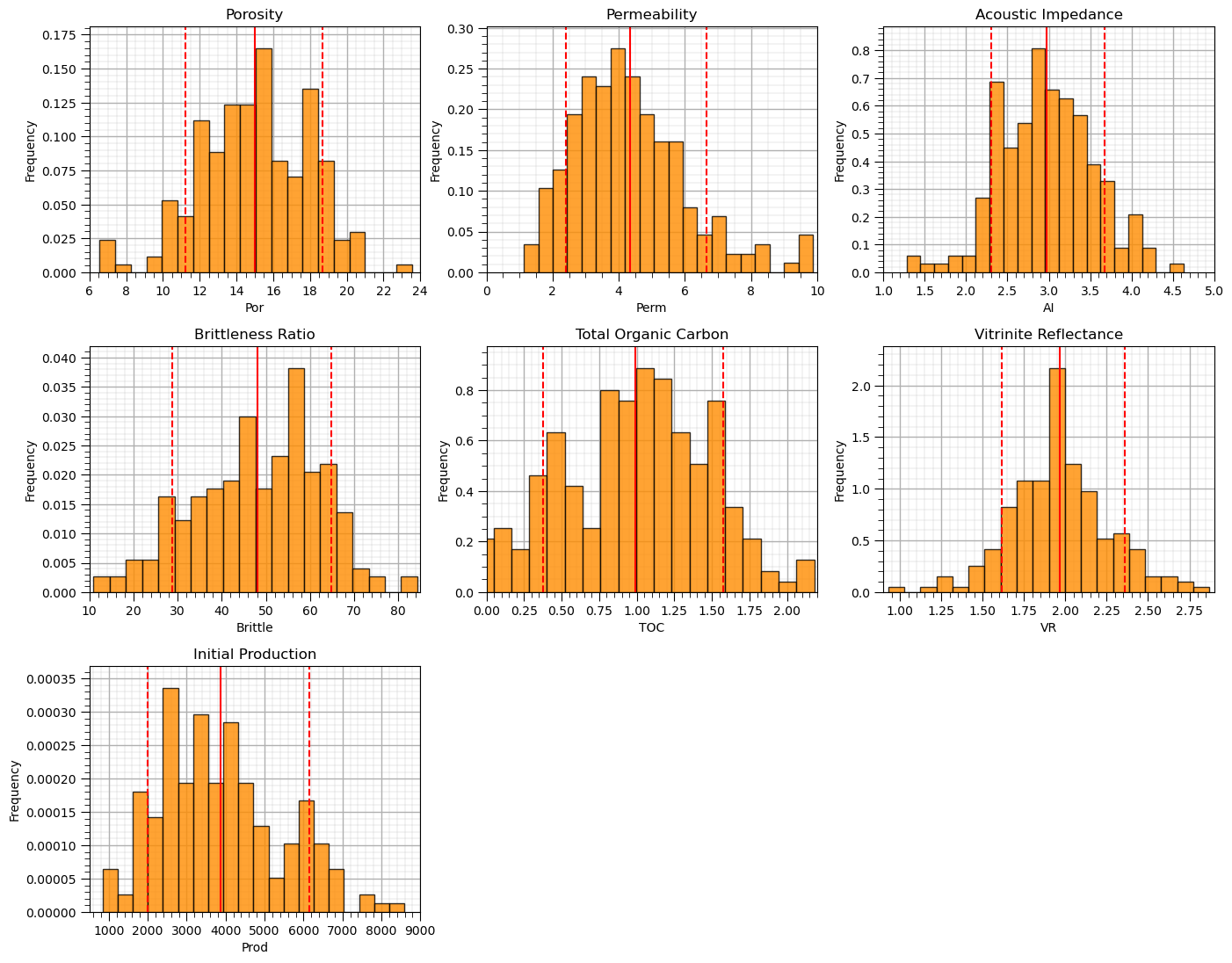
Now let’s step through, describe, demonstrate and visualize each feature transformation.
Fortunately, there are just a couple slightly negative values, this is a great segue into our first feature transformation.
Truncation#
It is possible that the features may extend beyond the plausible range of values.
truncation is simply assigning values outside the range with a specific value
it is common to assign the minimum permissible value to outliers on the lower tail and visa versa
Truncation can be handled easily with numpy operators applied to the feature array within the Pandas DataFrame
num = df._get_numeric_data()
num[num < data_min] = data_min
num[num > data_max] = data_max
plt.subplot(121)
plt.hist(df['TOC'].values,color='darkorange',alpha=0.8,edgecolor='black',bins=np.linspace(-0.2,1.0,25))
plt.xlabel('TOC (fraction)'); plt.ylabel('Frequency'); plt.title('Original Histogram'); plt.ylim([0,14]); plt.xlim([-0.2,1.0])
plt.gca().grid(which='minor', color='#EEEEEE', linestyle=':', linewidth=0.5)
plt.gca().grid(which='major', color='#DDDDDD', linewidth=0.8); plt.gca().minorticks_on()
old_TOC = df['TOC'].values.copy()
num = df._get_numeric_data() # get the numerical values
num[num < 0] = 0 # truncate negative values to 0.0
df.describe().transpose() # get the summary statistics of all features
plt.subplot(122)
plt.hist(df['TOC'].values,color='red',alpha=0.8,edgecolor='black',bins=np.linspace(-0.2,1.0,25),zorder=10)
plt.hist(old_TOC,color='darkorange',alpha=0.8,edgecolor='black',bins=np.linspace(-0.2,1.0,25),zorder=20)
plt.xlabel('TOC (fraction)'); plt.ylabel('Frequency'); plt.title('Truncated (>0.0) Histogram'); plt.ylim([0,14]); plt.xlim([-0.2,1.0])
plt.fill_between([-0.2,0.0],[14,14],[0,0],color='grey',alpha=1.0,zorder=30); plt.plot([0.0,0.0],[0,14],color='black',ls='--',zorder=30)
plt.gca().grid(which='minor', color='#EEEEEE', linestyle=':', linewidth=0.5)
plt.gca().grid(which='major', color='#DDDDDD', linewidth=0.8); plt.gca().minorticks_on()
plt.subplots_adjust(left=0.0, bottom=0.0, right=2.0, top=1.1, wspace=0.2, hspace=0.2); plt.show()

Let’s look at the summary statistics again to confirm that we were successful in truncating TOC to \(\ge 0\).
df.describe().transpose()
| count | mean | std | min | 25% | 50% | 75% | max | |
|---|---|---|---|---|---|---|---|---|
| Por | 200.0 | 14.991150 | 2.971176 | 6.550000 | 12.912500 | 15.070000 | 17.402500 | 23.550000 |
| Perm | 200.0 | 4.330750 | 1.731014 | 1.130000 | 3.122500 | 4.035000 | 5.287500 | 9.870000 |
| AI | 200.0 | 2.968850 | 0.566885 | 1.280000 | 2.547500 | 2.955000 | 3.345000 | 4.630000 |
| Brittle | 200.0 | 48.161950 | 14.129455 | 10.940000 | 37.755000 | 49.510000 | 58.262500 | 84.330000 |
| TOC | 200.0 | 0.991950 | 0.478264 | 0.000000 | 0.617500 | 1.030000 | 1.350000 | 2.180000 |
| VR | 200.0 | 1.964300 | 0.300827 | 0.930000 | 1.770000 | 1.960000 | 2.142500 | 2.870000 |
| Prod | 200.0 | 3864.407081 | 1553.277558 | 839.822063 | 2686.227611 | 3604.303506 | 4752.637555 | 8590.384044 |
From the summary statistics you can see that the truncation was successful, we now have a minimum of 0.0.
Affine Correction#
The affine correction is the transform of the feature distribution to a new mean and variance.
this is a shift and stretch / squeeze of the original property distribution
no shape change is assumed
The following equation is applied to each sample in the original distribution
where \(\sigma_x\) is the original standard deviation, \(\sigma_y\) is the target standard deviation, \(\overline{x}\) is the original mean and \(\overline{y}\) is the target mean.
there is an affine function in GeostatsPy that we may use
for brevity we will just transform a single feature, note the function is not set up to transform more than one feature at a time, nor does the function handle the back transformation.
Let’s transform porosity to have an arbitrary mean and standard deviation (\(\overline{x} = 20\%\) and \(\sigma_x = 3\%\))
df['aPor'] = GSLIB.affine(df['Por'].values,tmean = 22.0,tstdev = 1.5) # affine correction
plt.subplot(121)
plt.hist(df['Por'].values,color='yellow',alpha=0.4,edgecolor='black',bins=np.linspace(0.0,30.0,30),label='Original')
plt.hist(df['aPor'].values,color='red',alpha=0.4,edgecolor='black',bins=np.linspace(0.0,30.0,30),label='Transformed')
plt.hist(df['aPor'].values,fill=False,alpha=1.0,edgecolor='black',lw=2.0,bins=np.linspace(0.0,30.0,30))
plt.legend(loc='upper left'); plt.grid(True)
plt.xlabel('Porosity (%)'); plt.ylabel('Frequency'); plt.title('Original and Affine Transformed Histograms'); plt.ylim([0,60]); plt.xlim([0.0,30.0])
add_grid()
plt.subplot(122)
plt.plot(np.sort(df['Por']),np.linspace(0,1,len(df)),color='yellow',alpha=0.8,lw=3,zorder=10,label='Original', path_effects=[pe.Stroke(linewidth=7, foreground='black'), pe.Normal()])
plt.plot(np.sort(df['aPor']),np.linspace(0,1,len(df)),color='red',alpha=0.8,lw=3,zorder=10,label='Transformed', path_effects=[pe.Stroke(linewidth=7, foreground='black'), pe.Normal()])
plt.xlim([0,30]); plt.ylim(0,1); plt.xlabel('Porosity (%)'); plt.ylabel('Cumulative Probability');
plt.title('Original and Affine Transformed CDFs'); plt.legend(loc='upper left'); plt.grid(True)
add_grid()
plt.subplots_adjust(left=0.0, bottom=0.0, right=2.0, top=1.2, wspace=0.2, hspace=0.2); plt.show()
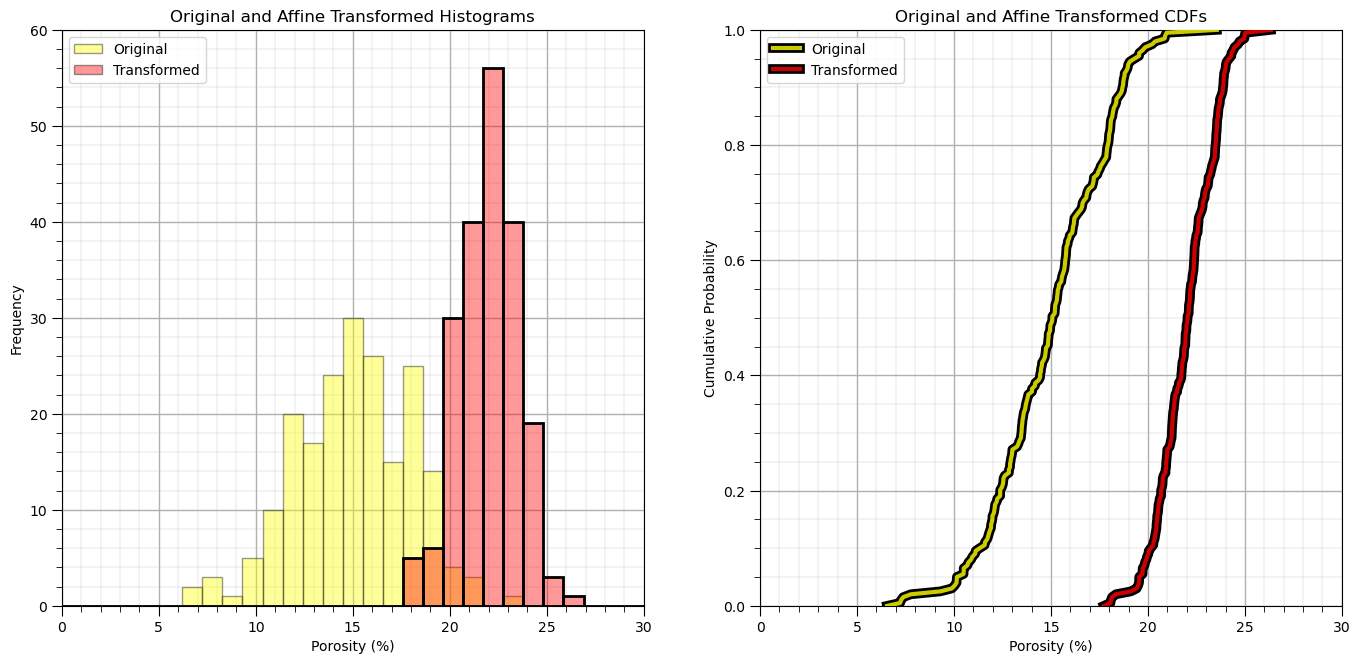
Let’s check the summary statistics of our new feature.
df['aPor'].describe().transpose()
count 200.000000
mean 22.000000
std 1.503764
min 17.727787
25% 20.947959
50% 22.039907
75% 23.220426
max 26.331783
Name: aPor, dtype: float64
Let’s remove the affine transformed feature.
df = df.drop(columns = ['aPor'])
Standardization#
Standardization is the transform of the feature distribution to a mean of zero and a variance of one.
this is a shift and stretch / squeeze of the original property distribution
no shape change is assumed
The transform is effectively a specific case of the affine correction, with \(\overline{y} = 0\) and \(\sigma_y = 1.0\).
\begin{equation} y = \frac{1}{\sigma_x}\left( x - \overline{x} \right) \end{equation}
where \(\sigma_x\) is the original standard deviation and \(\overline{x}\) is the original mean.
Let’s standardize the feature to have:
mean = 0.0
variance = standard deviation = 1.0
To do this we:
instantiate the StandardScaler from scikit learn. We assign it as ‘scaler’ object so we can use it to conveniently use this object to reverse the transformation, we will need to do that to get our predictions back into regular production units. The “scaler” object takes care of all the bookkeeping for us.
scaler = StandardScaler()
we then extract all the values from our DataFrame and apply the by-column standardization. The result is a 2D ndarray
sfeatures = scaler.fit_transform(df_mv.values)
we make an new empty DataFrame
df_nmv = pd.DataFrame()
then we add the transformed value to the new DataFrame while keeping the sample index and feature names from the old DataFramae
df_nmv = pd.DataFrame(sfeatures, index=df_mv.index, columns=df_mv.columns)
scaler = StandardScaler() # instantiate the scaler
sfeatures = scaler.fit_transform(df.values) # standardize all the values extracted from the DataFrame
df_st = pd.DataFrame() # instantiate a new DataFrame
df_st = pd.DataFrame(sfeatures, index=df.index, columns=df.columns) # copy the standardized values into the new DataFrame
plt.subplot(121)
plt.hist(df['Por'].values,color='yellow',alpha=0.4,edgecolor='black',bins=np.linspace(-5.0,30.0,36),label='Original')
plt.hist(df_st['Por'].values,color='red',alpha=0.4,edgecolor='black',bins=np.linspace(-5.0,30.0,36),label='Standardized')
plt.hist(df_st['Por'].values,fill=False,alpha=1.0,edgecolor='black',lw=2.0,bins=np.linspace(-5.0,30.0,36))
plt.legend(loc='upper left')
plt.xlabel('Porosity (%)'); plt.ylabel('Frequency'); plt.title('Original and Standardized Histograms'); plt.ylim([0,80]); plt.xlim([-5.0,25.0])
add_grid()
plt.subplot(122)
plt.plot(np.sort(df['Por']),np.linspace(0,1,len(df)),color='yellow',alpha=0.8,lw=3,zorder=10,label='Original',
path_effects=[pe.Stroke(linewidth=7, foreground='black'), pe.Normal()])
plt.plot(np.sort(df_st['Por']),np.linspace(0,1,len(df)),color='red',alpha=0.8,lw=3,zorder=10,label='Standardized',
path_effects=[pe.Stroke(linewidth=7, foreground='black'), pe.Normal()])
plt.xlim([-5,25]); plt.ylim(0,1); plt.xlabel('Porosity (%)'); plt.ylabel('Cumulative Probability');
plt.title('Original and Standardized CDFs'); plt.legend(loc='lower right'); plt.grid(True)
add_grid()
plt.subplots_adjust(left=0.0, bottom=0.0, right=2.0, top=1.2, wspace=0.2, hspace=0.2); plt.show()
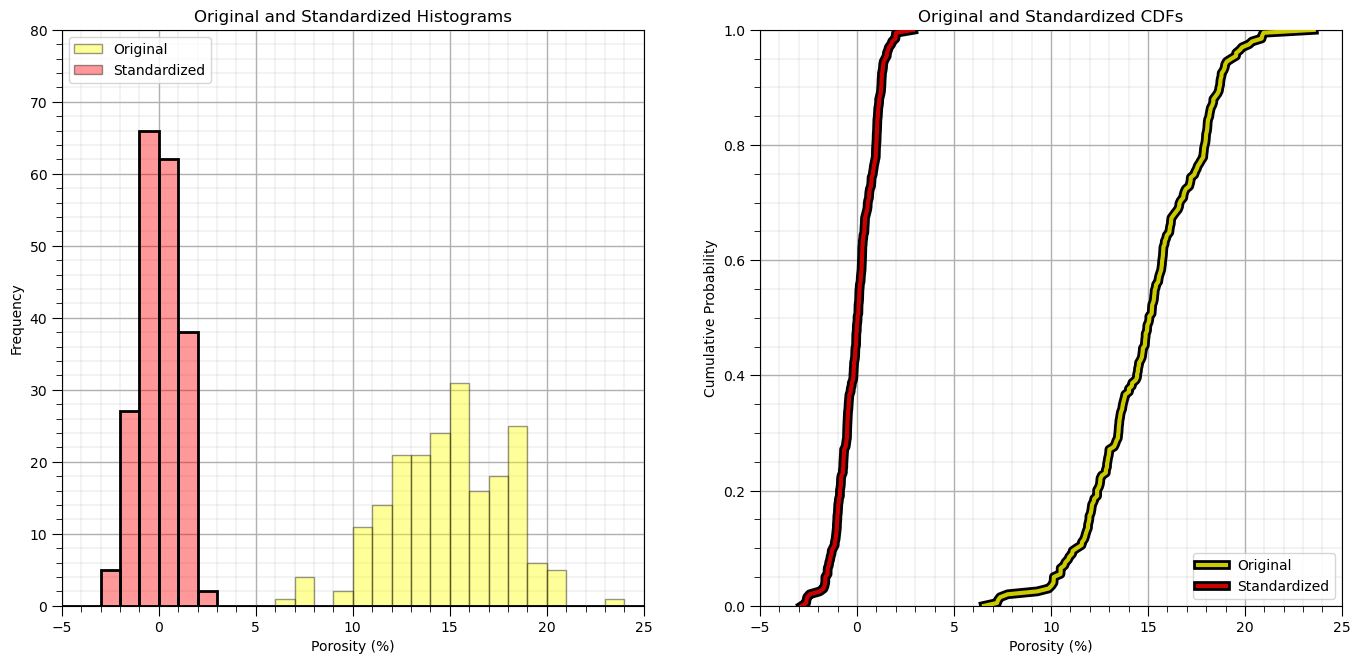
Let’s close the loop and reverse the transformation and confirm that we get back to the original data.
To do this we:
call the ‘fit’ features’ scaler’s inverse transform function transformed value to the new DataFrame while keeping the sample index and feature names from the old DataFramae
rfeatures = scaler.inverse_transform(df_st.values)
the output from this is a 2D numpy array.
We will put it into a new DataFrame.
df_reverse = pd.DataFrame(rfeatures, index=df.index, columns=df.columns)
rfeatures = scaler.inverse_transform(df_st.values)
df_reverse = pd.DataFrame(rfeatures, index=df.index, columns=df.columns) # copy the standardized values into the new DataFrame
df_reverse.head()
plt.subplot(131)
GSLIB.hist_st(df['Por'].values,0,30,log=False,cumul = False,bins=40,weights = None,xlabel='Porosity (%)',title='Original Porosity')
add_grid()
plt.subplot(132)
GSLIB.hist_st(df_st['Por'].values,-3,3,log=False,cumul = False,bins=40,weights = None,xlabel='Porosity Standardized',title='Standardized Porosity')
add_grid()
plt.subplot(133)
GSLIB.hist_st(df_reverse['Por'].values,0,30,log=False,cumul = False,bins=40,weights = None,xlabel='Porosity Reverse Standardization (%)',
title='Porosity Reverse Standardization')
add_grid()
plt.subplots_adjust(left=0.0, bottom=0.0, right=3.0, top=1.1, wspace=0.2, hspace=0.2)

You can confirm the result is the same as the original, prior to standardization DatatFrame.
We were just testing, so let’s get rid of (delete) the new DataFrame. We can use the following to delete an instantiated object in Python.
del df_reverse
For more complicated workflows it may be a good idea to remove intermediate products to save memory and to prevent clutter!
del df_reverse
Normalization#
Also known as the min / max transform, recales the features to have a minimum of 0 and a maximum of 1.
where \(min(x)\) and \(max(x)\) are the minimum and maximum values for each feature.
scikit learn has a built in min / max transform method
min_max_scaler = preprocessing.MinMaxScaler()
scaled_array = min_max_scaler.fit_transform(float_array)
norm_scaler = preprocessing.MinMaxScaler() # instantiate the scaler
nfeatures = norm_scaler.fit_transform(df.values) # standardize all the values extracted from the DataFrame
df_n = pd.DataFrame(nfeatures, index=df.index, columns=df.columns) # copy the standardized values into the new DataFrame
df_n.head()
plt.subplot(121)
plt.hist(df['Por'].values,color='yellow',alpha=0.4,edgecolor='black',bins=np.linspace(0.0,25.0,26),label='Original')
plt.hist(df_n['Por'].values,color='red',alpha=0.4,edgecolor='black',bins=np.linspace(0.0,25.0,26),label='Standardized')
plt.hist(df_n['Por'].values,fill=False,alpha=1.0,edgecolor='black',lw=2.0,bins=np.linspace(0.0,25.0,26))
plt.legend(loc='upper left')
plt.xlabel('Porosity (%)'); plt.ylabel('Frequency'); plt.title('Original and Standardized Histograms'); plt.ylim([0,80]); plt.xlim([0.0,25.0])
add_grid()
plt.subplot(122)
plt.plot(np.sort(df['Por']),np.linspace(0,1,len(df)),color='yellow',alpha=0.8,lw=3,zorder=10,label='Original',
path_effects=[pe.Stroke(linewidth=7, foreground='black'), pe.Normal()])
plt.plot(np.sort(df_n['Por']),np.linspace(0,1,len(df)),color='red',alpha=0.8,lw=3,zorder=10,label='Standardized',
path_effects=[pe.Stroke(linewidth=7, foreground='black'), pe.Normal()])
plt.xlim([0,25]); plt.ylim(0,1); plt.xlabel('Porosity (%)'); plt.ylabel('Cumulative Probability');
plt.title('Original and Standardized CDFs'); plt.legend(loc='lower right'); plt.grid(True)
add_grid()
plt.subplots_adjust(left=0.0, bottom=0.0, right=2.0, top=1.2, wspace=0.2, hspace=0.2); plt.show()
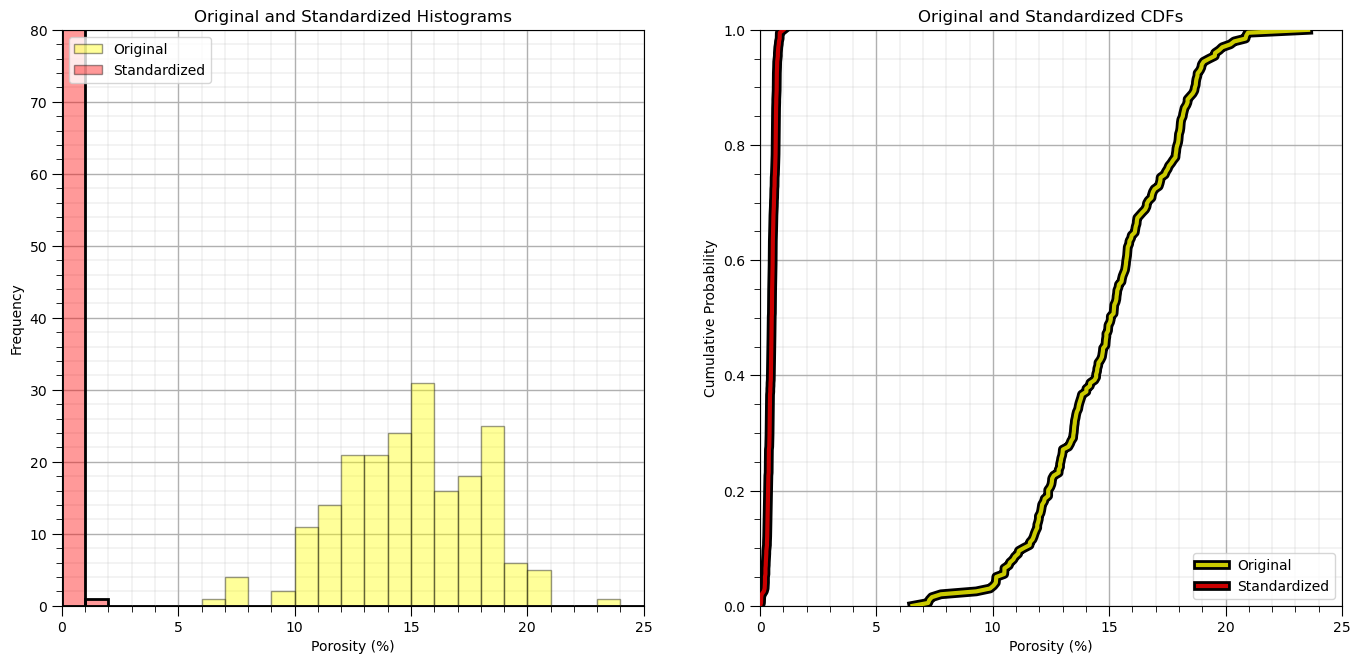
Let’s check the summary statistics.
df_n.describe().transpose()
| count | mean | std | min | 25% | 50% | 75% | max | |
|---|---|---|---|---|---|---|---|---|
| Por | 200.0 | 0.496538 | 0.174775 | 0.0 | 0.374265 | 0.501176 | 0.638382 | 1.0 |
| Perm | 200.0 | 0.366219 | 0.198057 | 0.0 | 0.227975 | 0.332380 | 0.475686 | 1.0 |
| AI | 200.0 | 0.504134 | 0.169220 | 0.0 | 0.378358 | 0.500000 | 0.616418 | 1.0 |
| Brittle | 200.0 | 0.507180 | 0.192526 | 0.0 | 0.365377 | 0.525548 | 0.644809 | 1.0 |
| TOC | 200.0 | 0.455023 | 0.219387 | 0.0 | 0.283257 | 0.472477 | 0.619266 | 1.0 |
| VR | 200.0 | 0.533144 | 0.155066 | 0.0 | 0.432990 | 0.530928 | 0.625000 | 1.0 |
| Prod | 200.0 | 0.390241 | 0.200408 | 0.0 | 0.238229 | 0.356681 | 0.504843 | 1.0 |
Let’s close the loop and reverse the transformation (back-transform) and confirm that we get back to the original data.
rfeatures = norm_scaler.inverse_transform(df_n.values)
df_reverse = pd.DataFrame() # instantiate a new DataFrame
df_reverse = pd.DataFrame(rfeatures, index=df.index, columns=df.columns) # copy the standardized values into the new DataFrame
df_reverse.head()
plt.subplot(131)
GSLIB.hist_st(df['Por'].values,0,30,log=False,cumul = False,bins=40,weights = None,xlabel='Porosity (%)',title='Original Porosity')
plt.subplots_adjust(left=0.0, bottom=0.0, right=2.0, top=1.1, wspace=0.2, hspace=0.2)
plt.subplot(132)
GSLIB.hist_st(df_n['Por'].values,0,1,log=False,cumul = False,bins=40,weights = None,xlabel='Porosity Normalized',title='Normalization Porosity')
plt.subplots_adjust(left=0.0, bottom=0.0, right=2.0, top=1.1, wspace=0.2, hspace=0.2)
plt.subplot(133)
GSLIB.hist_st(df_reverse['Por'].values,0,30,log=False,cumul = False,bins=40,weights = None,xlabel='Porosity Reverse Normalization (%)',
title='Porosity Reverse Normalization')
plt.subplots_adjust(left=0.0, bottom=0.0, right=3.0, top=1.1, wspace=0.2, hspace=0.2); plt.show()

You can confirm the result is the same as the original, prior to standardization DataFrame.
Once again we were just testing, so let’s delete the back-transformed DataFrame.
del df_reverse
L1 / L2 Normalizer#
Another type of normalization is performed independently on each sample to force the \(L1\) or \(L2\) norm to be 1.0.
For the L1 norm:
where we have \(x_{i, \alpha}, \alpha = 1, \dots, m\) features over \(i = 1, \dots, n\) samples.
For the L2 norm:
where we have \(x_{i, \alpha}, \alpha = 1, \dots, m\) features over \(i = 1, \dots, n\) samples.
this may be applied in text classification or clustering
We demonstrate the L1 and L2 normalizer below.
there is no reverse to this transform
Let’s start with the \(L2\) norm.
l2normalizer = Normalizer(norm = 'l2')
l2features = l2normalizer.fit_transform(df_n)
colors = ['#1f77b4', '#ff7f0e', '#2ca02c', '#d62728', '#9467bd', '#8c564b', '#e377c2','#7f7f7f', '#bcbd22', '#17becf']
names = ['Porosity','Permeability','Acoustic Impedance','Brittleness','Total Organic Carbon','Vitrinite Reflectance','Production']
plt.subplot(121)
n_cumul_sum =np.cumsum(np.power(df_n.values,2),axis=1)
for i in range(0,l2features.shape[1]):
plt.plot(np.linspace(0,len(df)-1,len(df)),n_cumul_sum[:,i])
plt.fill_between(np.linspace(0,len(df)-1,len(df)),n_cumul_sum[:,i],np.zeros(len(df)))
for i in range(1,l2features.shape[1]):
plt.fill_between(np.linspace(0,len(df)-1,len(df)),n_cumul_sum[:,i],n_cumul_sum[:,i-1])
plt.xlim([0,len(df)-1]); plt.ylim([0,5])
plt.xlabel('Sample (index)'); plt.ylabel('Features Cumulative Square'); plt.title('Original')
legend_elements = []
for i in range(len(names)):
legend_elements.append(Patch(facecolor=colors[i], edgecolor='black',label=names[i]))
plt.gca().legend(handles=legend_elements, loc='upper right')
add_grid()
plt.subplot(122)
l2_cumul_sum =np.cumsum(np.power(l2features,2),axis=1)
for i in range(0,l2features.shape[1]):
plt.plot(np.linspace(0,len(df)-1,len(df)),l2_cumul_sum[:,i])
plt.fill_between(np.linspace(0,len(df)-1,len(df)),l2_cumul_sum[:,i],np.zeros(len(df)))
for i in range(1,l2features.shape[1]):
plt.fill_between(np.linspace(0,len(df)-1,len(df)),l2_cumul_sum[:,i],l2_cumul_sum[:,i-1])
plt.xlim([0,len(df)-1]); plt.ylim([0,1])
plt.xlabel('Sample (index)'); plt.ylabel('Features Cumulative Square'); plt.title('L2 Normalized')
legend_elements = []
for i in range(len(names)):
legend_elements.append(Patch(facecolor=colors[i], edgecolor='black',label=names[i]))
plt.gca().legend(handles=legend_elements, loc='upper right')
add_grid()
plt.subplots_adjust(left=0.0, bottom=0.0, right=2.0, top=1.2, wspace=0.2, hspace=0.2); plt.show()
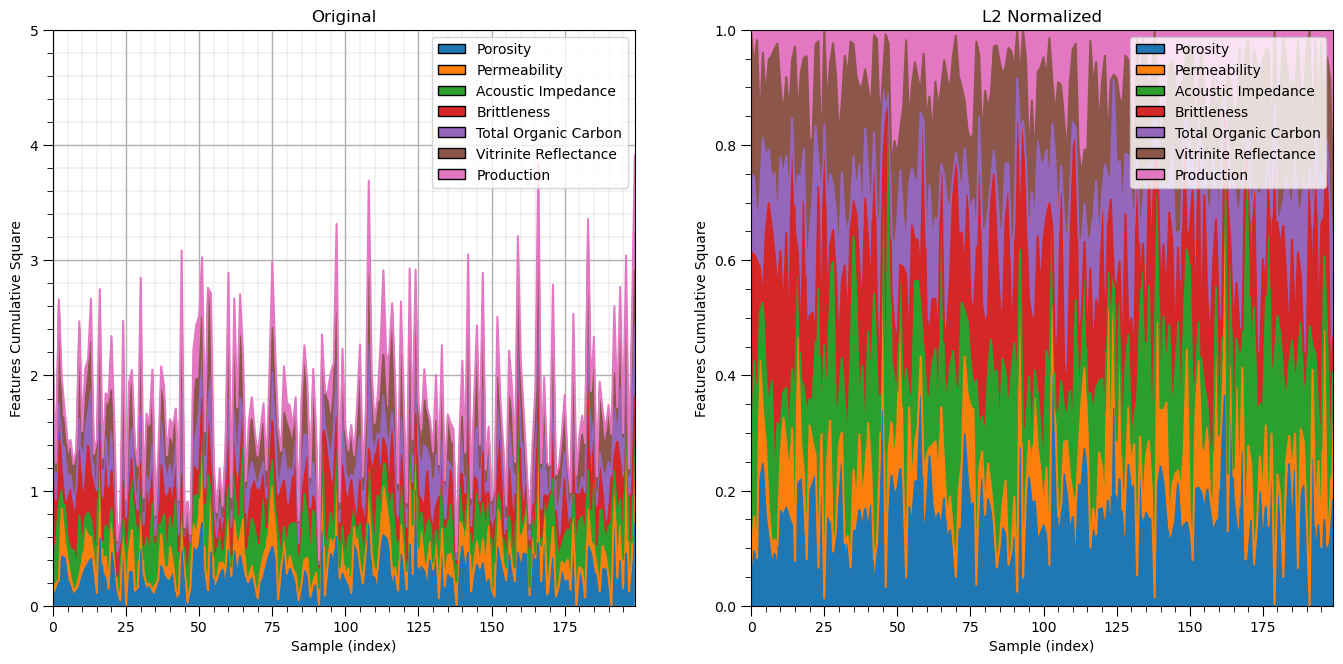
Now let’s demonstrate the \(L1\) norm.
l1normalizer = Normalizer(norm = 'l1')
l1features = l1normalizer.fit_transform(df_n) # standardize all the values extracted from the DataFrame
df_nL1 = pd.DataFrame() # instantiate a new DataFrame
df_nL1 = pd.DataFrame(l1features, index=df.index, columns=df.columns) # copy the standardized values into the new DataFrame
df_nL1.head()
colors = ['#1f77b4', '#ff7f0e', '#2ca02c', '#d62728', '#9467bd', '#8c564b', '#e377c2','#7f7f7f', '#bcbd22', '#17becf']
names = ['Porosity','Permeability','Acoustic Impedance','Brittleness','Total Organic Carbon','Vitrinite Reflectance','Production']
plt.subplot(121)
n_cumul_sum =np.cumsum(df_n.values,axis=1)
for i in range(0,l1features.shape[1]):
plt.plot(np.linspace(0,len(df)-1,len(df)),n_cumul_sum[:,i])
plt.fill_between(np.linspace(0,len(df)-1,len(df)),n_cumul_sum[:,i],np.zeros(len(df)))
for i in range(1,l1features.shape[1]):
plt.fill_between(np.linspace(0,len(df)-1,len(df)),n_cumul_sum[:,i],n_cumul_sum[:,i-1])
plt.xlim([0,len(df)-1]); plt.ylim([0,5])
plt.xlabel('Sample (index)'); plt.ylabel('Features Cumulative'); plt.title('Original')
legend_elements = []
for i in range(len(names)):
legend_elements.append(Patch(facecolor=colors[i], edgecolor='black',label=names[i]))
plt.gca().legend(handles=legend_elements, loc='upper right')
plt.subplot(122)
l1_cumul_sum =np.cumsum(l1features,axis=1)
for i in range(0,l1features.shape[1]):
plt.plot(np.linspace(0,len(df)-1,len(df)),l1_cumul_sum[:,i])
plt.fill_between(np.linspace(0,len(df)-1,len(df)),l1_cumul_sum[:,i],np.zeros(len(df)))
for i in range(1,l1features.shape[1]):
plt.fill_between(np.linspace(0,len(df)-1,len(df)),l1_cumul_sum[:,i],l1_cumul_sum[:,i-1])
plt.xlim([0,len(df)-1]); plt.ylim([0,1])
plt.xlabel('Sample (index)'); plt.ylabel('Features Cumulative'); plt.title('L1 Normalized')
legend_elements = []
for i in range(len(names)):
legend_elements.append(Patch(facecolor=colors[i], edgecolor='black',label=names[i]))
plt.gca().legend(handles=legend_elements, loc='upper right')
plt.subplots_adjust(left=0.0, bottom=0.0, right=2.0, top=1.2, wspace=0.2, hspace=0.2); plt.show()
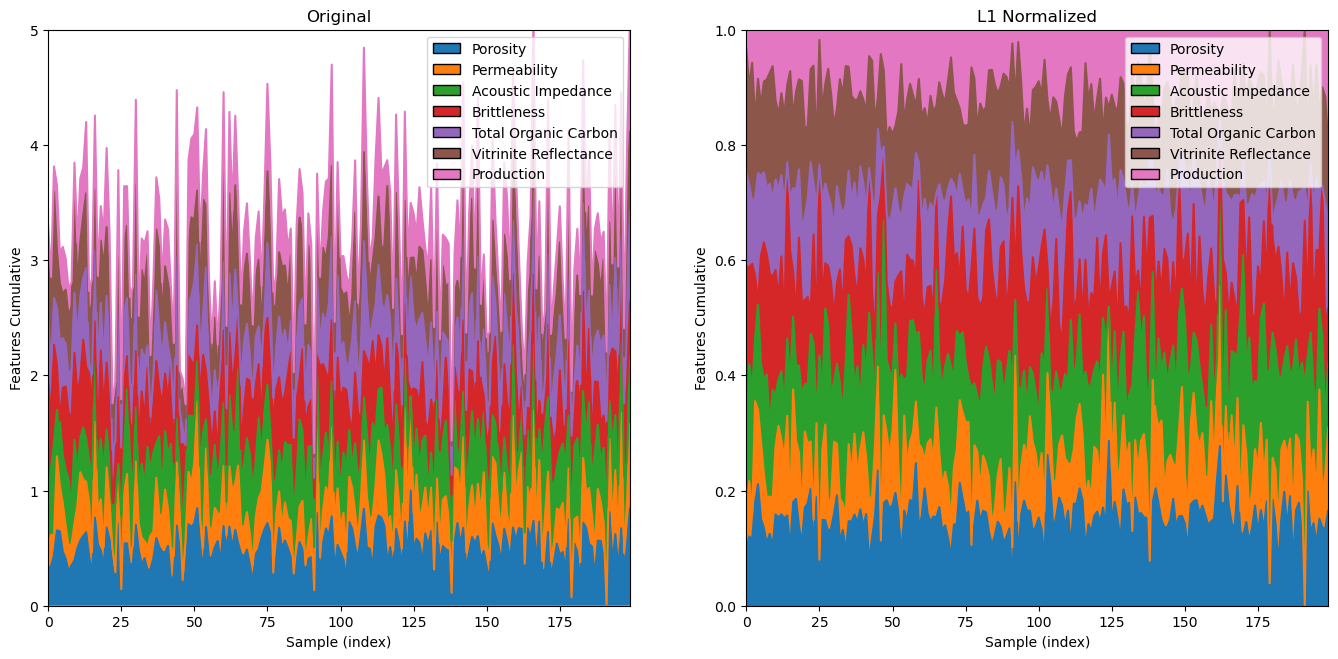
Binary or Indictor Transform#
For the many problems that we need to perform a binary transform to convert our continuous feature to 0’s and 1’s based on a threshold, \(x_t\)
for the binary transform, \(x_i = 0\) if \(<= x_t\) and \(x_i = 1\) otherwise
for the indicator transform, \(x_i = 1\) if \(<= x_t\) and \(x_i = 0\) otherwise
There is a scikit-learn function for the binary transform
threshold = 13.0
binarizer = Binarizer(threshold = threshold)
bPor = binarizer.fit_transform(df['Por'].values.reshape(-1, 1)) # standardize all the values extracted from the DataFrame
plt.subplot(121)
GSLIB.hist_st(df['Por'].values,0,30,log=False,cumul = False,bins=40,weights = None,xlabel='Porosity (%)',title='Original Porosity')
add_grid()
plt.subplot(122)
GSLIB.hist_st(bPor,0,1,log=False,cumul = False,bins=40,weights = None,xlabel='Porosity Indicator Transform',
title='Porosity Indicator Transform, Threshold = ' + str(threshold))
add_grid()
plt.subplots_adjust(left=0.0, bottom=0.0, right=2.0, top=1.1, wspace=0.2, hspace=0.2)
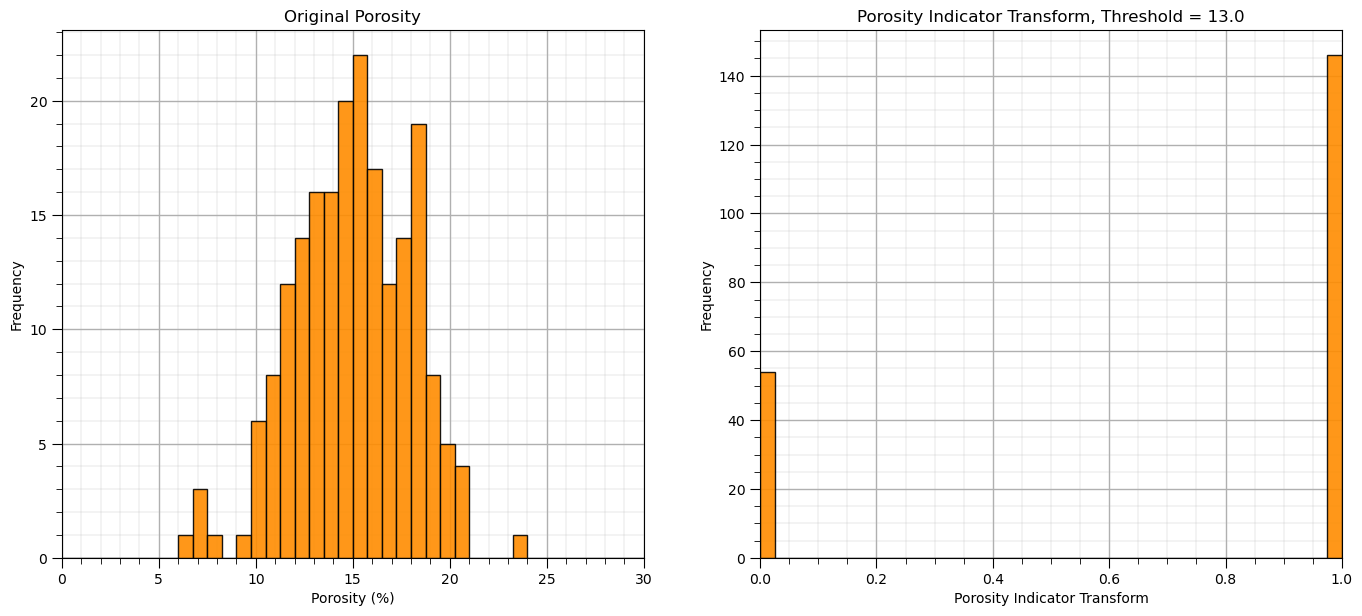
k Bins Discretization#
With k bins discretization we bin the range of the feature into K bins and then expand each sample for our continuous feature to K features with the assignment of a value of 1 if the sample is within a bin and 0 if outsize the bin
strategies include uniform width bins (uniform) and uniform number of data in each bin (quantile)
Let’s make 5 uniform bins and then concatenate the original porosity values so we can compare the original porosity values and our K bins discretization.
nbins = 5
kbins = KBinsDiscretizer(n_bins=nbins, strategy='uniform',encode='onehot')
kbins_por = kbins.fit_transform(df['Por'].values.reshape(-1, 1)) # standardize all the values extracted from the DataFrame
kbins_values = np.concatenate((df['Por'].values.reshape(-1, 1),kbins_por.toarray()),axis=1)
kbins_values
array([[12.08, 0. , 1. , 0. , 0. , 0. ],
[12.38, 0. , 1. , 0. , 0. , 0. ],
[14.02, 0. , 0. , 1. , 0. , 0. ],
...,
[12.12, 0. , 1. , 0. , 0. , 0. ],
[15.55, 0. , 0. , 1. , 0. , 0. ],
[20.89, 0. , 0. , 0. , 0. , 1. ]])
Let’s visualize the k bins discretization.
look at original data distribution and the bin boundaries to better understand the result above.
kbins_edges = kbins.bin_edges_[0]
kbins_centers = (kbins_edges[1:] + kbins_edges[:-1]) / 2
bsiz = (np.max(kbins_edges) - np.min(kbins_edges))/nbins
fig = plt.figure(figsize=(6, 6))
gs = fig.add_gridspec(2,2 ,width_ratios=(1.0, 1.0))
plt_scatter = fig.add_subplot(gs[0, 1])
plt_x = fig.add_subplot(gs[0, 0],sharey=plt_scatter)
plt_y = fig.add_subplot(gs[1, 1],sharex=plt_scatter)
for i in range(0,len(df)):
ones = kbins_centers[kbins_values[i][1:] == 1.0]
plt_scatter.scatter(ones,np.full(len(ones),kbins_values[i][0]),marker = 'o',s=10,color='red')
zeros = kbins_centers[kbins_values[i][1:] == 0.0]
plt_scatter.scatter(zeros,np.full(len(zeros),kbins_values[i][0]),color='black',s=5,marker='x',lw=0.4)
#print(zeros,np.full(len(zeros),kbins_values[i][0]))
for edge in kbins_edges:
plt_scatter.plot([edge,edge],[0,30],color='black',lw=1,ls='--',alpha=0.5)
#plt.plot([5,25],[edge,edge],color='black',lw=1,ls='--',alpha=0.5)
for icenter,center in enumerate(kbins_centers):
plt_scatter.annotate('Bin ' + str(icenter),[center-bsiz*0.1,5.2])
plt_scatter.set_ylabel(r'Original Feature, $X$'); plt_scatter.set_xlabel(r'Transformed Features, $X^{\prime}$')
plt_scatter.set_xlim([5,25]); plt_scatter.set_ylim([5,25])
plt_scatter.scatter(-9999.9,99999,marker = 'o',s=10,color='red',label='1')
plt_scatter.scatter(-9999.9,99999,color='black',s=5,marker='x',lw=0.4,label='0')
plt_scatter.set_xticks(kbins_edges)
plt_scatter.legend(loc='upper left')
plt_scatter.set_title('K Bins Discretization, One Hot Encoding of Continuous Feature')
plt_x.hist(df['Por'].values,orientation='horizontal',density = False,weights = np.ones(len(df))/len(df),
color='red',alpha=0.8,edgecolor='black',bins=np.linspace(5.0,25.0,30))
plt_x.set_xlim([0.13,0.0])
plt_x.set_ylabel(r'Original Feature, $X$'); plt_x.set_xlabel(r'Probability')
plt_x.set_title('Original Feature')
z_values = np.zeros(int(np.sum(kbins_values[:,1:])))
count = np.sum(kbins_values[:,1:],axis=0)
ii = 0
for i in range(0,kbins_values[:,1:].shape[1]):
for j in range(0,int(count[i])):
z_values[ii] = kbins_centers[i]
ii = ii + 1
plt_y.hist(z_values,orientation='vertical',density = False,weights = np.ones(len(df))/len(df),
color='red',alpha=0.8,edgecolor='black',bins=np.linspace(5.0,25.0,30),zorder=10)
plt_y.hist(df['Por'].values,orientation='vertical',density = False,weights = np.ones(len(df))/len(df),
color='red',alpha=0.2,edgecolor='black',bins=np.linspace(5.0,25.0,30),zorder=5)
for edge in kbins_edges:
plt_y.plot([edge,edge],[0,0.6],color='black',lw=1,ls='--',alpha=0.5)
for icenter,center in enumerate(kbins_centers):
plt_y.annotate('Bin ' + str(icenter),[center-bsiz*0.21,0.58])
plt_y.plot([center,center],[0,0.6],color='grey',lw=1,alpha=0.5,zorder=1)
plt_y.annotate(str(np.round(center,1)),[center+bsiz*0.01,0.5],rotation=270.0,color='grey')
plt_y.set_ylim([0.0,0.6])
plt_y.set_xlabel(r'Transformed Features, $X^{\prime}$'); plt_y.set_ylabel(r'Probability')
plt.subplots_adjust(left=0.0, bottom=0.0, right=1.6, top=1.6, wspace=0.2, hspace=0.2)
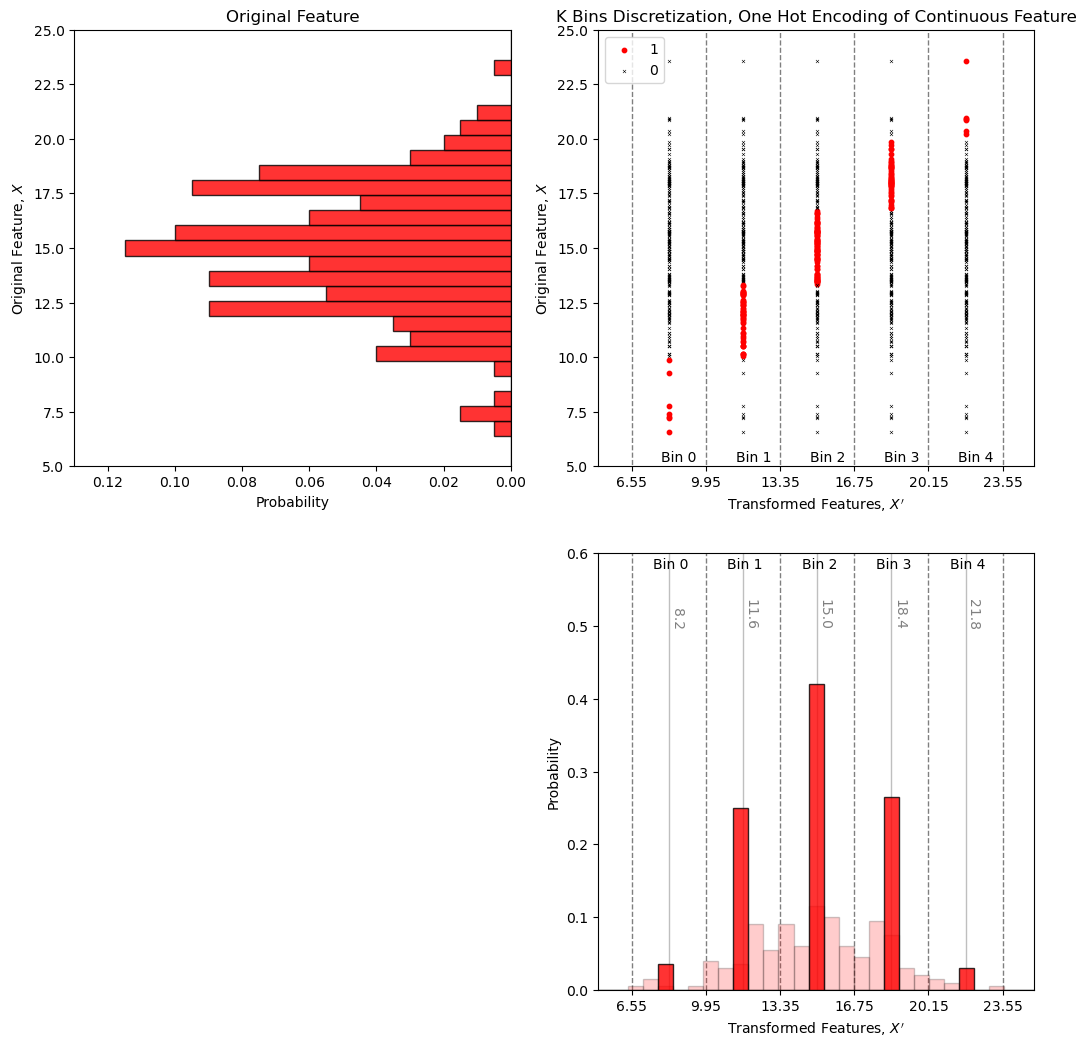
Spot check the first sample, \(12.08\%\) porosity is \(\in [9.95\%,13.35\%]\) so we have a 1 in the second bin (second column in our table) and zeros in the other bins.
General Distribution Transformation#
The distribution transformation may be applied to transform any distribution, \(F_x(x)\) to any other distribution, \(F_y(y)\).
the target distribution, \(F_y(y)\), could be nonparametric, i.e., a set of values. In this case the data is converted to a CDF and some form of interpolation is applied to find the inverse of the target CDF, \(F_y^{-1}(p)\), for any cumulative probability, \(p\)
the target distribution, \(F_y(y)\), could be any parametric distribution, and the calculation of the inverse of the target CDF, \(F_y^{-1}(p)\), for any cumulative probability, \(p\) is available through an analytical solution
I have built out an interactive Python dashboard Distribution Transformation with a transformation to a parametric distribution,

and a transformation to a nonparametric distribution,

Distribution Transformation to a Parametric Distribution#
We can transform our data feature distribution to any parametric distribution with this workflow.
Calculate the cumulative probability value of each of our data values, \(p_{\alpha} = F_x(x_\alpha)\), \(\forall\) \(\alpha = 1,\ldots, n\).
Apply the inverse of the target parametric cumulative distribution function (CDF) to calculate the transformed values. \(y_{\alpha} = G_y^{-1}\left(F_x(x_\alpha)\right)\), \(\forall\) \(\alpha = 1,\ldots, n\).
While assigning the cumulative probabilities you must make an assumption about the distribution tails (minimum and maximum values).
known tail - the minimum or maximum value in the dataset is the minimum or maximum value of the distribution
unknown tail - the minimum or maximum value of the distribution is known
For each possible case we calculate cumulative probability of the sorted in ascending order data as,
known lower and upper tail,
unknown lower and known upper tail,
known lower and unknown upper tail,
unknown upper and lower tail,
this is more important with sparsely sampled datasets. When \(n\) is large this is not as important,
the range of cumulative probability at the tails is very small!
the minimum and maximum of the feature may be well-known
Gaussian Transform / Gaussian Anamorphosis#
We showed that the correction of the mean to 0.0 and standard deviation to 1.0 with affine correction does not change the shape; therefore, does not make a Gaussian distributed property.
for many statistic or geostatistical methods the assumption of Gaussian distributed is required. We need normal score transforms in many subsurface modeling workflows
Gaussian anamorphosis is applied through the cumulative distribution functions (CDF)s, \(F_{X}\), to a new CDF , \(G_{Y}\). This can be generalized with the quantile - quantile transformation applied to all the sample data:
The forward transform:
The reverse transform:
Here’s a visualization of the Gaussian transformation,

Let’s look at the original cumulative distribution function and Gaussian transformed cumulative distribution function for a single feature by-hand.
por = df['Por'].copy(deep = True).values # make a deepcopy of the feature from the DataFrame
por = np.sort(por) # sort the data in ascending order
n = por.shape[0] # get the number of data samples
cprob = np.zeros(n)
for i in range(0,n):
index = i + 1
cprob[i] = index / n # known upper tail
# cprob[i] = (index - 1)/n # known lower tail
# cprob[i] = (index - 1)/(n - 1) # known upper and lower tails
# cprob[i] = index/(n+1) # unknown tails
y = np.zeros(n)
for i in range(0,n):
y[i] = norm.ppf(cprob[i],loc=0.0,scale=1.0)
plt.subplot(121)
plt.plot(por,cprob, alpha = 0.2, c = 'black') # plot piecewise linear interpolation
plt.scatter(por,cprob,s = 10, alpha = 1.0, c = 'red', edgecolor = 'black') # plot the CDF points
plt.grid(); plt.xlim([5,25]); plt.ylim([0.0,1.0])
plt.xlabel("Porosity (fraction)"); plt.ylabel("Cumulative Probability"); plt.title("Non-parametric Porosity Cumulative Distribution Function")
plt.subplot(122)
plt.plot(y,cprob, alpha = 0.2, c = 'black') # plot piecewise linear interpolation
plt.scatter(y,cprob,s = 10, alpha = 1.0, c = 'red', edgecolor = 'black') # plot the CDF points
plt.grid(); plt.xlim([-3.0,3.0]); plt.ylim([0.0,1.0])
plt.xlabel("Porosity (fraction)"); plt.ylabel("Cumulative Probability"); plt.title("After Distribution Transformation to Gaussian")
plt.subplots_adjust(left=0.0, bottom=0.0, right=2.0, top=1.2, wspace=0.2, hspace=0.2); plt.show()
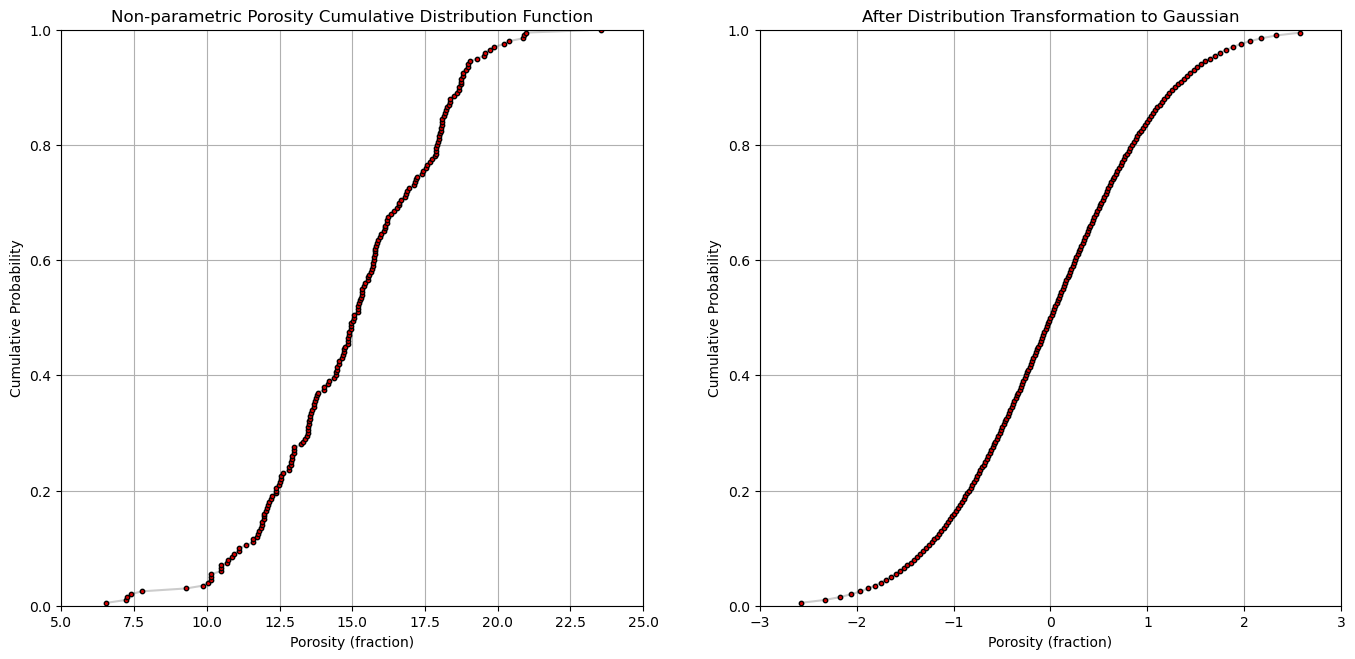
Now let’s perform the Gaussian transformation with a function.
from sklearn.preprocessing import QuantileTransformer
nscore = QuantileTransformer(n_quantiles=100, random_state=73, output_distribution = 'normal')
nsfeatures = nscore.fit_transform(df) # standardize all the values extracted from the DataFrame
df_ns = pd.DataFrame() # instantiate a new DataFrame
df_ns = pd.DataFrame(nsfeatures, index=df.index, columns=df.columns) # copy the standardized values into the new DataFrame
df_ns.head()
plt.subplot(121)
GSLIB.hist_st(df['Por'].values,0,30,log=False,cumul = False,bins=40,weights = None,xlabel='Porosity (%)',title='Original Porosity')
add_grid()
plt.subplot(122)
GSLIB.hist_st(df_ns['Por'].values,-3,3,log=False,cumul = False,bins=40,weights = None,xlabel='Porosity Normal Score',title='Standard Normal Porosity')
add_grid()
plt.subplots_adjust(left=0.0, bottom=0.0, right=2.0, top=1.1, wspace=0.2, hspace=0.2); plt.show()
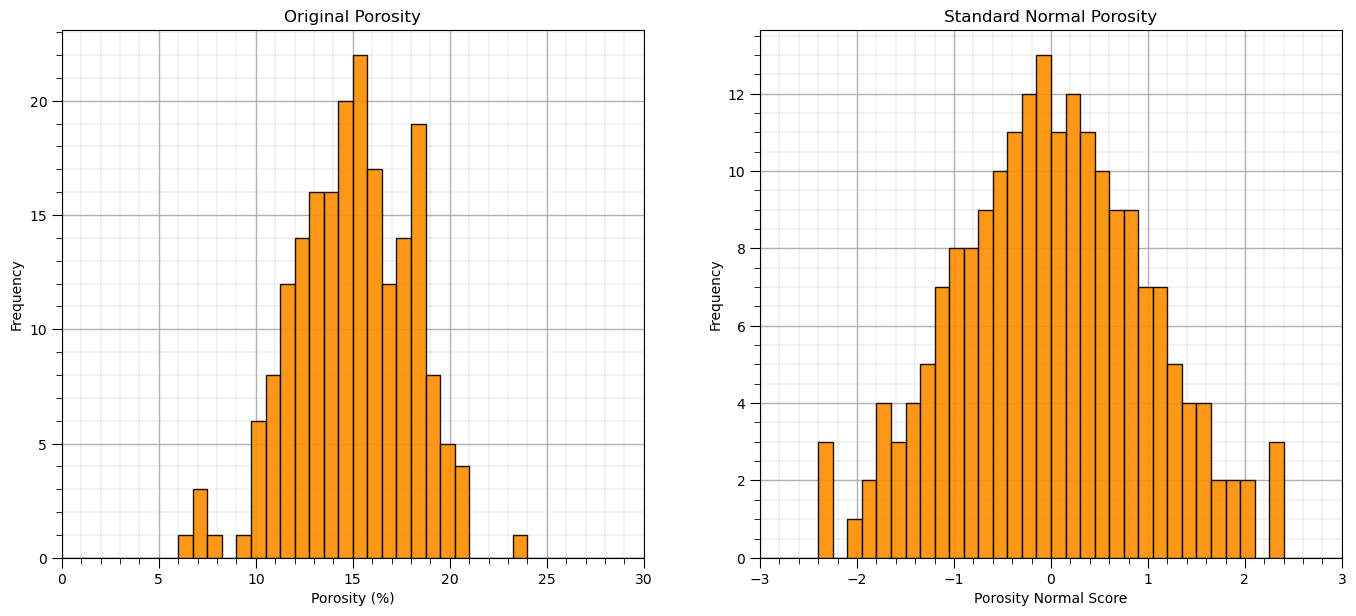
Let’s visualize the Gaussian transformed feature histograms.
we should see a nice bell shape centered on 0.0 with a range of about -4 to 4.
nbins = 30 # number of histogram bins
for i, feature in enumerate(features): # plot histograms with central tendency and P10 and P90 labeled
plt.subplot(3,3,i+1)
y,_,_ = plt.hist(x=df_ns[feature],weights=None,bins=nbins,alpha = 0.8,edgecolor='black',color='darkorange',density=True)
histogram_bounds(values=df_ns[feature].values,weights=np.ones(len(df)),color='red')
plt.xlabel(feature); plt.ylabel('Frequency'); plt.ylim([0.0,y.max()*1.10]); plt.title(featuretitle[i]); add_grid()
plt.xlim([-3.0,3.0])
plt.subplots_adjust(left=0.0, bottom=0.0, right=2., top=2.1, wspace=0.2, hspace=0.3); plt.show()
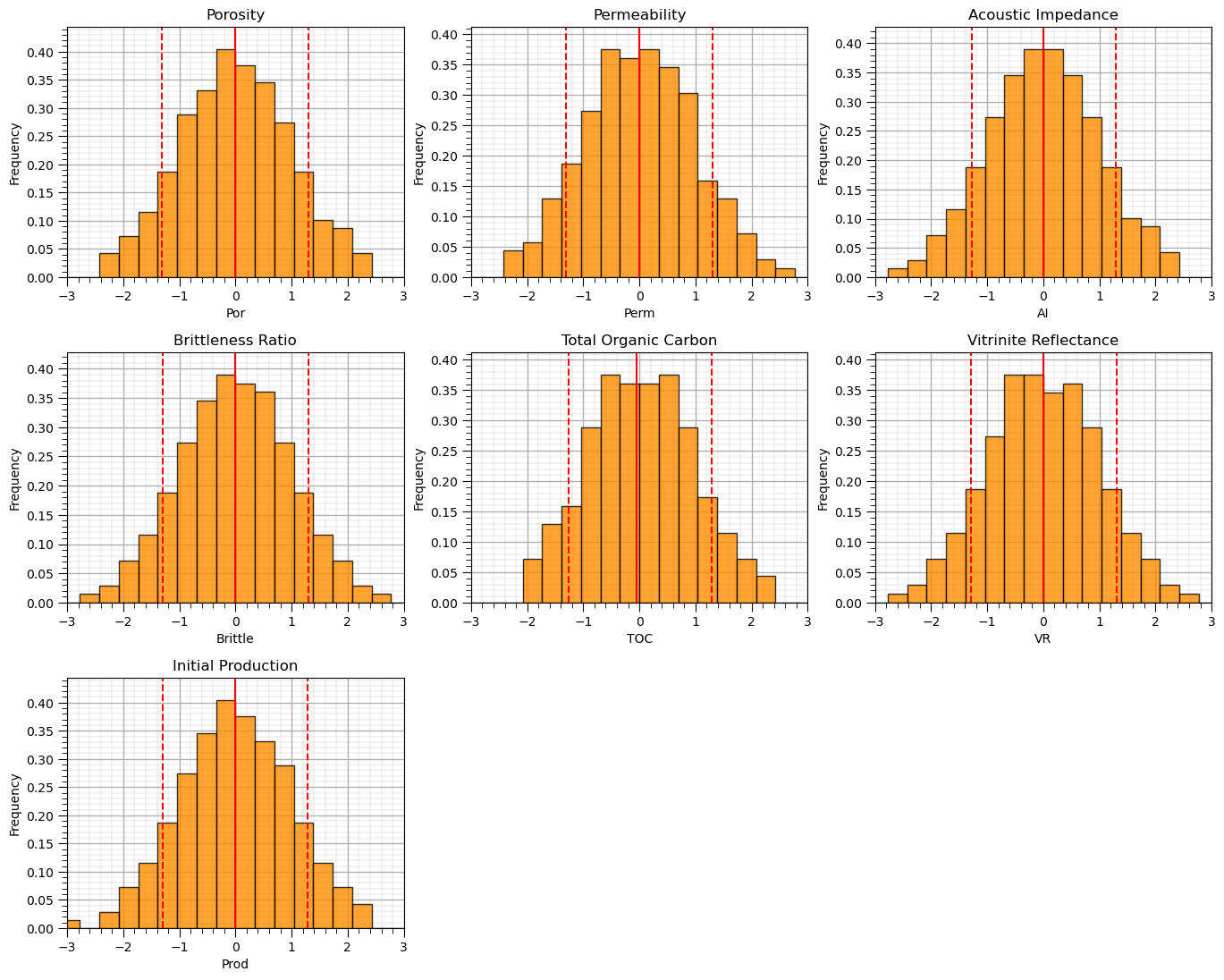
Once again, let’s check out the reverse transform, from Gaussian back to the original features.
\begin{equation} x = F_x^{-1}(G_y(y)) \end{equation}
rfeatures = nscore.inverse_transform(df_ns.values)
df_reverse = pd.DataFrame() # instantiate a new DataFrame
df_reverse = pd.DataFrame(rfeatures, index=df.index, columns=df.columns) # copy the standardized values into the new DataFrame
plt.subplot(131)
GSLIB.hist_st(df['Por'].values,0,30,log=False,cumul = False,bins=40,weights = None,xlabel='Porosity (%)',title='Original Porosity')
add_grid()
plt.subplot(132)
GSLIB.hist_st(df_ns['Por'].values,-3,3,log=False,cumul = False,bins=40,weights = None,xlabel='Porosity Normal Score',title='Standard Normal Porosity')
add_grid()
plt.subplot(133)
GSLIB.hist_st(df_reverse['Por'].values,0,30,log=False,cumul = False,bins=40,weights = None,xlabel='Porosity Reverse Normal Score (%)',
title='Porosity Reverse Gaussian Transform')
add_grid()
plt.subplots_adjust(left=0.0, bottom=0.0, right=3.0, top=1.1, wspace=0.2, hspace=0.2)

Quantile / Uniform[0,1] Transform#
We can also perform a uniform transform, this is known as the quantile transformation to the cumulative probability values.
the cumulative probability values have a uniform distribution.
uniform = QuantileTransformer(n_quantiles=100, random_state=73, output_distribution = 'uniform')
unifeatures = uniform.fit_transform(df) # standardize all the values extracted from the DataFrame
df_uni = pd.DataFrame() # instantiate a new DataFrame
df_uni = pd.DataFrame(unifeatures, index=df.index, columns=df.columns) # copy the standardized values into the new DataFrame
plt.subplot(121)
GSLIB.hist_st(df['Por'].values,0,30,log=False,cumul = False,bins=40,weights = None,xlabel='Porosity (%)',title='Original Porosity')
add_grid()
plt.subplot(122)
GSLIB.hist_st(df_uni['Por'].values,0,1,log=False,cumul = False,bins=40,weights = None,xlabel='Porosity Uniform Transform',
title='Uniform Transform Porosity')
add_grid()
plt.subplots_adjust(left=0.0, bottom=0.0, right=2.0, top=1.1, wspace=0.2, hspace=0.2)
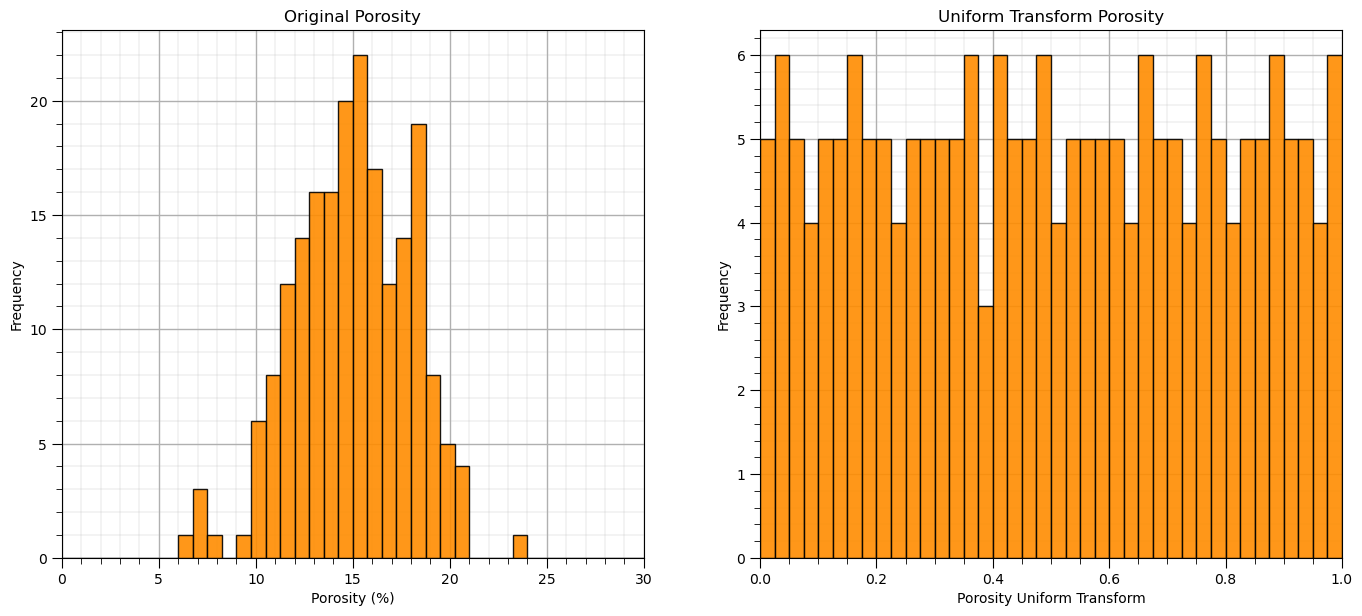
Let’s visualize the uniform transformed feature histograms.
we should see a uniform frequencies (with some noise due to limited sampling) \(\in [0,1]\).
nbins = 30 # number of histogram bins
for i, feature in enumerate(features): # plot histograms with central tendency and P10 and P90 labeled
plt.subplot(3,3,i+1)
y,_,_ = plt.hist(x=df_uni[feature],weights=None,bins=nbins,alpha = 0.8,edgecolor='black',color='darkorange',density=True)
histogram_bounds(values=df_uni[feature].values,weights=np.ones(len(df)),color='red')
plt.xlabel(feature); plt.ylabel('Frequency'); plt.ylim([0.0,y.max()*1.10]); plt.title(featuretitle[i]); add_grid()
plt.xlim([0.0,1.0])
plt.subplots_adjust(left=0.0, bottom=0.0, right=2., top=2.1, wspace=0.2, hspace=0.3); plt.show()
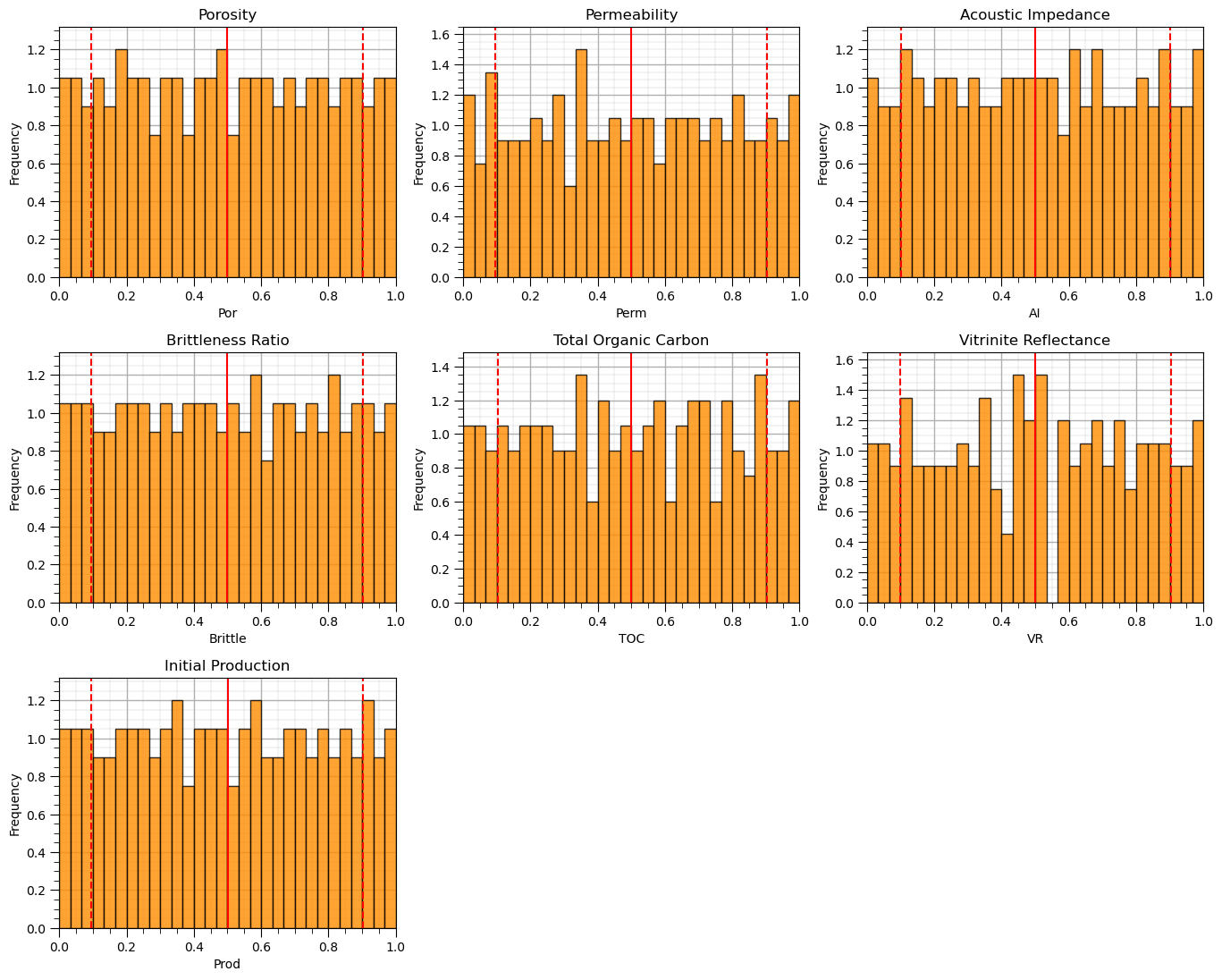
We now have features with uniform distributions \([0,1]\).
Custom Feature Transforms#
We can also create our own custom feature transformation. We can specify our own transform within a scikit-learn preprocessing function
this allows us to have a convenient method for forward and reverse transforms of our features as we have seen above
Let’s demonstrate with the natural log for the forward transform and the exponential for the reverse transform.
Here’s the code to make our custom feature transformation,
custom_transformer = FunctionTransformer(func = np.log, inverse_func = np.exp)
custom_transformer = FunctionTransformer(func = np.log, inverse_func = np.exp, check_inverse = True, validate=True)
custom_features = custom_transformer.fit_transform(df['Perm'].values.reshape(-1, 1)) # standardize all the values extracted from the DataFrame
df_custom = pd.DataFrame(custom_features, columns = ['LogPerm']) # instantiate a new DataFrame
df_custom.head()
plt.subplot(121)
GSLIB.hist_st(df['Perm'].values,0,15,log=False,cumul = False,bins=40,weights = None,xlabel='Permeability (mD)',title='Original Permeability')
add_grid()
plt.subplot(122)
GSLIB.hist_st(df_custom['LogPerm'].values,0,3,log=False,cumul = False,bins=40,weights = None,xlabel='Permeability Log Transform',
title='Custom Transform - Log Transformed Permeability')
add_grid()
plt.subplots_adjust(left=0.0, bottom=0.0, right=2.0, top=1.1, wspace=0.2, hspace=0.2)
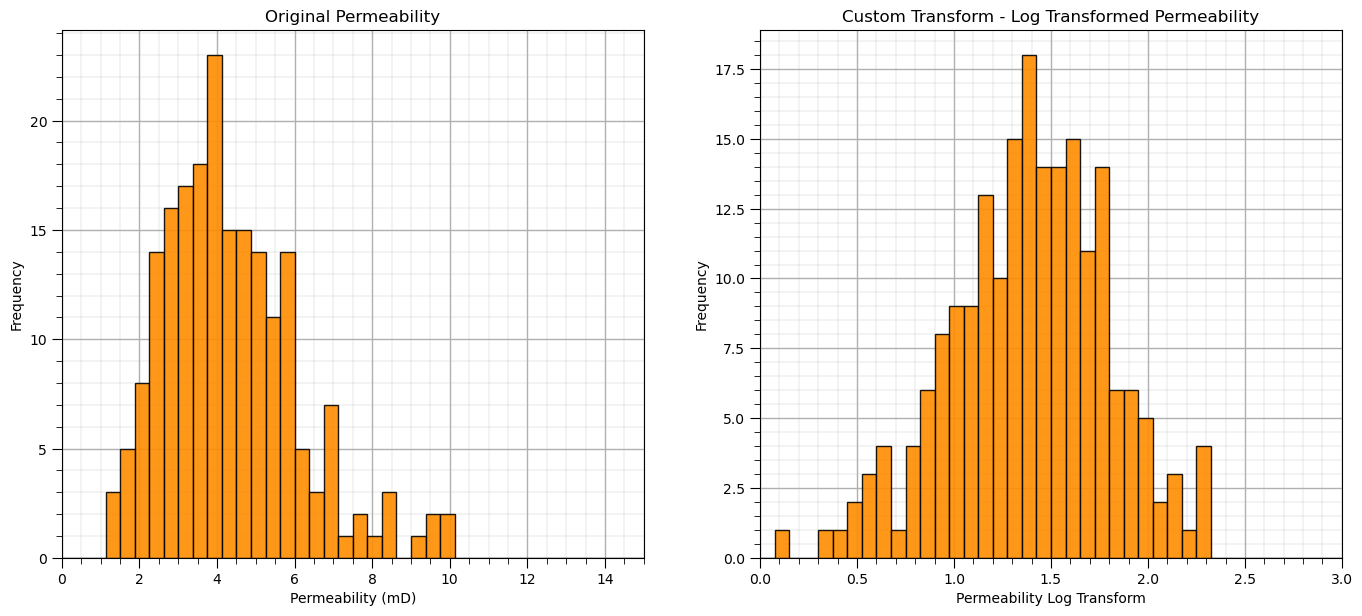
Let’s demonstrate that our custom transform is reversible.
rfeatures = custom_transformer.inverse_transform(df_custom.values)
df_reverse = pd.DataFrame(rfeatures, index=df_custom.index, columns=['Perm']) # copy the standardized values into the new DataFrame
plt.subplot(131)
GSLIB.hist_st(df['Perm'].values,0,15,log=False,cumul = False,bins=40,weights = None,xlabel='Permeability (mD)',title='Original Permeability')
add_grid()
plt.subplot(132)
GSLIB.hist_st(df_custom['LogPerm'].values,0,3,log=False,cumul = False,bins=40,weights = None,xlabel='Pemeability Log Transform',
title='Custom Transform - Log Transformed Permeability')
add_grid()
plt.subplot(133)
GSLIB.hist_st(df_reverse['Perm'].values,0,15,log=False,cumul = False,bins=40,weights = None,xlabel='Permeability (mD)',title='Original Permeability')
add_grid()
plt.subplots_adjust(left=0.0, bottom=0.0, right=2.0, top=1.1, wspace=0.2, hspace=0.2); plt.show()
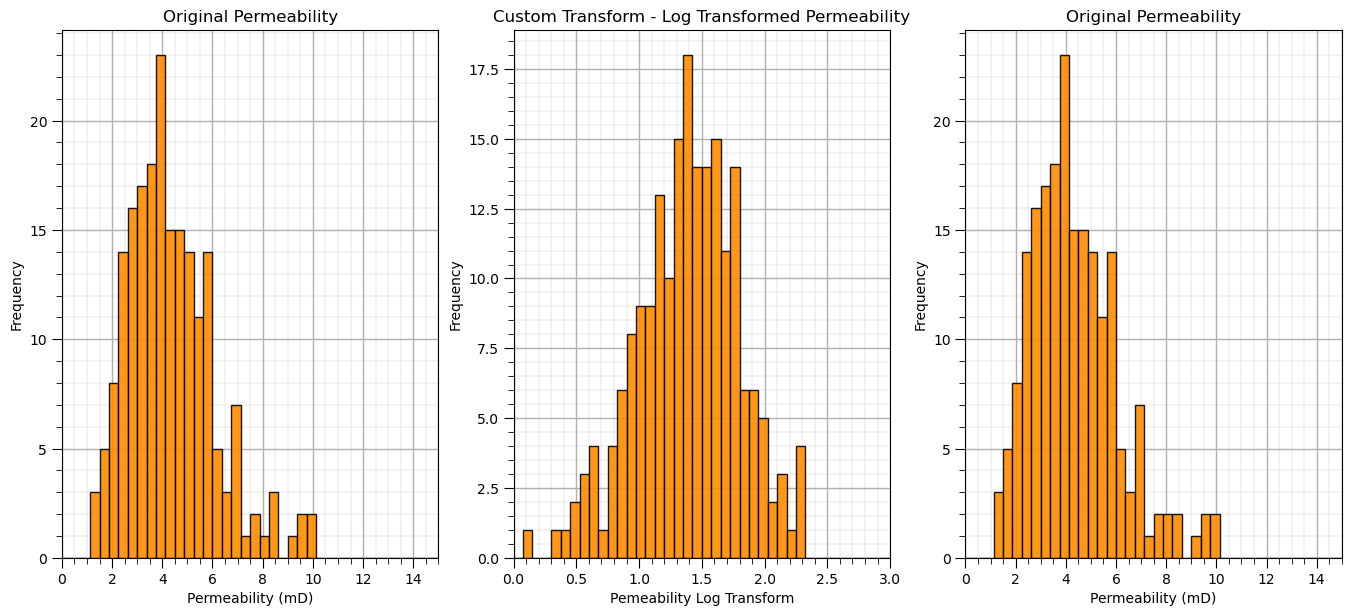
Compare the back-transformed permeability values to the original dataset. The reverse transform that we specified with our custom transformation works!
Want to Work Together?#
I hope this content is helpful to those that want to learn more about subsurface modeling, data analytics and machine learning. Students and working professionals are welcome to participate.
Want to invite me to visit your company for training, mentoring, project review, workflow design and / or consulting? I’d be happy to drop by and work with you!
Interested in partnering, supporting my graduate student research or my Subsurface Data Analytics and Machine Learning consortium (co-PI is Professor John Foster)? My research combines data analytics, stochastic modeling and machine learning theory with practice to develop novel methods and workflows to add value. We are solving challenging subsurface problems!
I can be reached at mpyrcz@austin.utexas.edu.
I’m always happy to discuss,
Michael
Michael J. Pyrcz, Ph.D., P.Eng. Professor, Cockrell School of Engineering and The Jackson School of Geosciences, The University of Texas at Austin
More Resources Available at: Twitter | GitHub | Website | GoogleScholar | Geostatistics Book | YouTube | Applied Geostats in Python e-book | Applied Machine Learning in Python e-book | LinkedIn
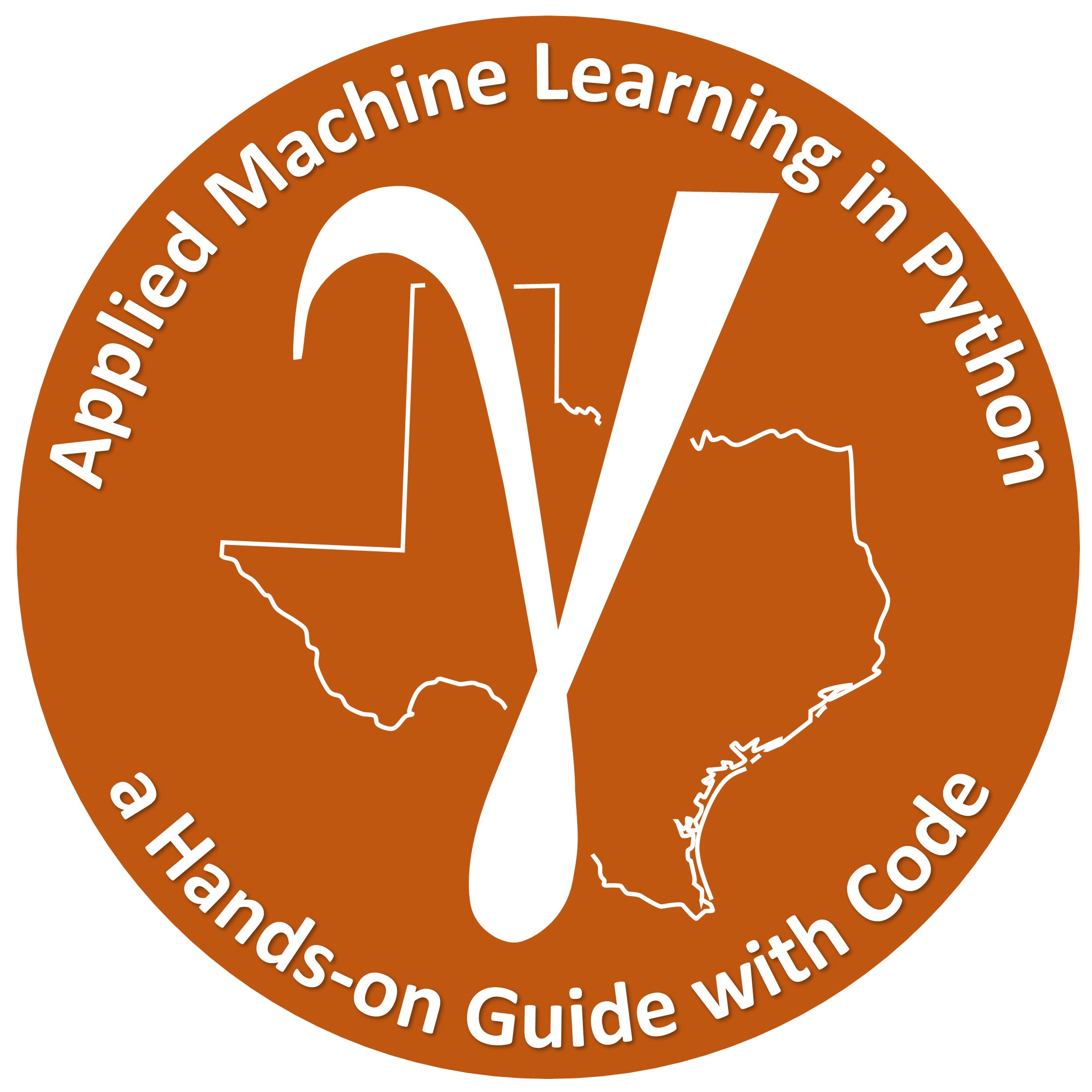
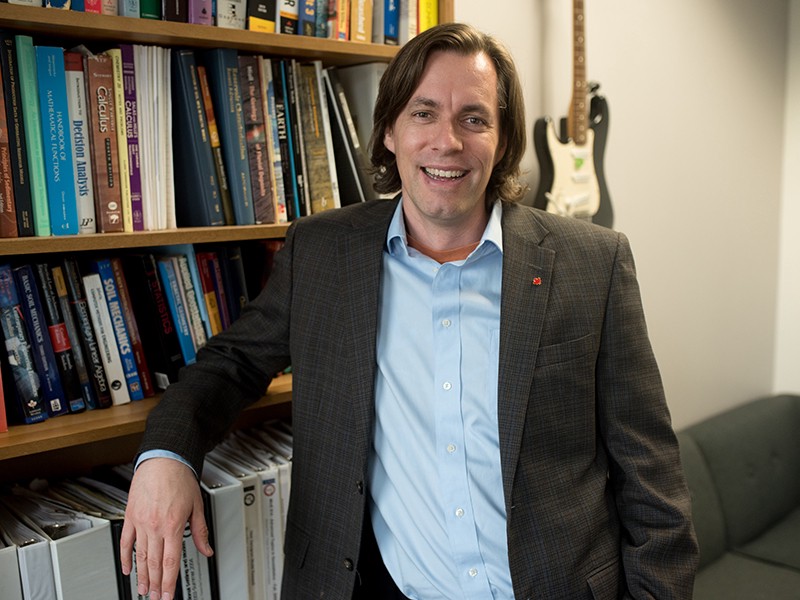
Comments#
This was a basic treatment of feature transformations. Much more could be done and discussed, I have many more resources. Check out my shared resource inventory and the YouTube lecture links at the start of this chapter with resource links in the videos’ descriptions.
I hope this is helpful,
Michael